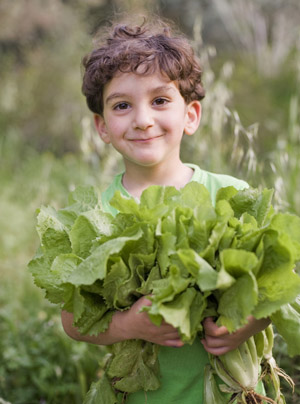 |
Benjamin Franklin was a giant on whose shoulders I’m honored to stand, but I’d humbly add one more certainty to his list: food. From our first days and hours of life, our world revolves around food. It often consumes us as much as we consume it. As parents, most of us hope to raise healthy, self-regulating, adventurous eaters. While there’s no surefire way to promote a love affair with local, nourishing foods, it’s not like throwing sand into the wind, either. Parents often lament, “My child will only eat chicken fingers and macaroni and cheese!” And while this is likely true, you’d be hard-pressed to get a request like this from a child who’d never tasted the fare. Let’s start at the beginning. It’s biologically normal to nourish new life at the breast. Babies were designed to eat around the clock, and some spend as many as twelve hours a day nursing. Infants may not know how to tell time, but they are born knowing how much and how long they need to eat. We count on our newborns to tell us when they’re hungry, and if they’re nursing, they’re able to tell us when they’re full, too. Many parents change gears when babies are around six months old. When solid food enters the picture, we forget that our little ones still know when they’re hungry or full. Mainstream practices of introducing table food takes control away from babies, and hands it back to mom or dad. We’re choo-chooing a spoon into babies’ mouths, making them a passive recipient of something they haven’t had a chance to touch, smell, or manipulate. And I’d venture to say, it’s not that yummy. Baby Food: A Newborn Industry Around the turn of the 20th century, industrialization launched a love affair with processed food. Canned goods replaced backyard gardens and trips to the local farmer. Families gained the luxury of eating fruits and vegetables all year round. This sudden ease of food preparation, coupled with a medical community lobbying for earlier and earlier introductions of solids, paved the way for a new industry: baby food. Mothers marveled at the convenience of jarred, prepared foods, but what these well-intentioned women often didn’t know, because no laws mandated ingredient disclosure, was that commercial baby food included a lot of “others”—salt, sugar, fillers, artificial preservatives, and occasionally, lead and glass shards. In the 1980s and 90s, several major baby food products were recalled, but the industry suffered little. Even as recently as 2010, lead could be found in baby food. In light of these issues, some parents turned back to making their own purees. Baby food blenders stole some share in the baby gear market. Parents peeled, boiled, milled, and froze ice cube trays of orange vegetables. Time consuming? Yes. Frustrating when baby spits out lovingly prepared sweet potato? You betcha. I’m thankful that the story doesn’t end here. Baby-Led Weaning One feeding trend (re)gaining popularity is “baby-led weaning,” a phrase coined by Gill Rapley, a public health nurse. During her days as a visiting health provider, she was struck by the struggles so many parents faced during mealtimes. Spoon-fed babies had difficulties with textures and flavors. While working on her Master’s thesis, Rapley discovered that when control was handed to babies, many of these issues vanished. She went on to write Baby-Led Weaning: Helping Your Baby To Love Good Food, a seminal text on what our pre-industrial ancestors already knew. The theory is really quite simple. Around six months, parents offer food to their baby. Forget blenders, jars, and aeroplaned mush. Baby-led weaning starts babies on real, flavorful, healthy food, right from the start. Ready for the method? Let your baby choose how, what, and how much to eat. It’s that easy – much less work for parents, and way more fun for baby. Before you jump on board, you may be wondering about choking and allergies. Protecting precious babies is always on the forefront of a new parent’s mind. According to Rapley, babies who feed themselves may be less likely to choke than their spoon-fed peers. Babies go through a logical progression of skills during their first year: reach, grab, chew, pincher grip. “Thus, a very young baby cannot easily put himself at risk because he cannot get small hard pieces of food into his mouth—and he keeps the food at the front of his mouth while he chews it. Spoon feeding, by contrast, encourages the baby to suck the food straight to the back of his mouth, potentially making choking more likely.” And then there are allergies. There’s no solid data for global incidences, but the rate is rising. In the U.S., approximately eight percent of children and four percent of adults have serious reactions to food. Science has shown that the best thing you can do to protect your baby from developing allergies is to breastfeed exclusively through six months of age (or provide your baby with donor milk). Breast milk colonizes babies’ intestinal lining with beneficial, disease-fighting, immune-boosting bacteria. Though it’s not a surefire way to avoid allergies, it’s the best we’ve got. Some scientists are backing a theory implicating diet for the allergy increase. In a 2010 study comparing kids in rural Burkina Faso to urban Florence, Italy, those who ate locally grown fruits and vegetables had more diverse gut flora than children whose mainstay was refined sugar and flour, and high calorie foods. Other scientists hypothesize we’re introducing “high-allergen” foods too late. If you have a family history of allergies, it’s a wise move to pass on the peanuts, but there’s no evidence this should be a global mandate. In fact, a 2008 study in the Journal of Allergy and Clinical Immunology suggests otherwise. Delays may actually increase the risk of allergies. The study compared peanut allergies among Jewish children living in London and Israel. Only ten percent of British children had been introduced to peanuts by the time they were nine months, compared to sixty-nine percent of the Israeli babies. The British children had a much higher incidence of allergies! Gardening with Children A natural extension of the spirit of baby-led weaning is to grow your own food, with your children, for your family’s consumption. For some, this comes naturally. For others, it’s daunting. But fear not. A garden can be as simple as a pot on your porch. And tending to it should be easier than getting your kids to pick up their toys. The Buy-in. It’s not hard to bring children on board a gardening project. Little ones love playing in the dirt; they’re curious; and they’re eager helpers. Gardening is fertile ground for practicing environmental stewardship, and practical life skills. Best of all, you’re providing the next generation with a foundation for healthy eating and a roadmap for sustainability. If you’re enthusiastic, your children likely will be too. Plus, an eagerly anticipated carrot, hiding for months underground with just a tuft of green plumage poking through the soil, is much more alluring when plucked from your own backyard. Syndal Dmochkowski, an avid veggie eater says, “Everyone in my neighborhood growing up grew something different, and then we shared our harvest. I still didn’t like certain veggies, but I ate fresh cucumbers and peas at every summer meal. I’m not sure I would have tried them if I hadn’t be invited into the experience. Choosing seeds. Toddlers, preschoolers, and older children can all be involved in the planning process. Depending on space and climate, choose appropriate vegetables and offer your children pictures of some of their current favorite veggies, and a few you think they might like to try. For older children, thumbing through a seed catalog is a fun project for the winter months. Local gardening clubs or farmers’ markets may offer free seeds or seedlings. While you may be itching to plant some exotic veggies, keep in mind that some plants are more kid-friendly than others. Read: easy to grow, easy to harvest. Perennial favorites include sunflowers (seeds can be roasted or saved for next year’s crop), sugar snap peas, cherry or grape tomatoes, low-growing bush beans, and if you have the room, pumpkins and blueberry bushes! Massachusetts mom Emily van Nort has three girls, all of whom are actively involved in the gardening process. “I’ve let them pick which veggies they want to grow. When I let the five-year-old choose last year, we ended up with eight cherry tomato plants in all sorts of awesome colors.” The gear. A sturdy set of child-sized trowels is worth the investment. Little gardeners are more efficient when their tools match their hands. Cheap plastic tools tend to frustrate novice workers. Skip the gloves. Soil under the nails can be washed away at the end of the day, but you can’t duplicate the feel of dirt running through your fingers, or the squirm of an earthworm in your palm. While most gardeners have a special pair of shoes, barefoot is actually best. Kids’ feet aren’t fully formed until age 18 or older! Going shoeless is not only a boon to bones, but it’s good for our health. An emerging body of evidence is proving that direct contact with the earth assists in promoting optimal health. Of course, you’ll want to be mindful of any trash, animal droppings, or lead in your soil. Prep. You don’t have to explain photosynthesis, soil pH, and germination for your child to learn. Try to resist lengthy explanations, and focus on hands-on learning instead. Marcy Axness, author of Parenting for Peace says, “Gardening with young ones is such a wonderful gift when we don’t over-talk it. We parents have such a tendency to want to make ‘teachable moments’! In this instance the mysterious seeds, the smell and feel of the rich soil, the rhythmicity of the sowing, tending, and harvesting times, and your enjoyment of it—your consciousness of possibility, and the beauty of Nature’s cycles—those are the teaching agents.” In other words, relax. Tap into that natural excitement over seemingly “magic” occurrences: seeds that sprout up over night, delicious grape tomatoes that “pop” in the mouth, and the wonder of digging up a potato. Start-up. If this is your first season planting with little ones, you may want to start small. Giving your children ownership of just one plant sets them up for success without being overwhelming. Van Nort’s girls each have their own spot of land to tend. “Last year three-year-old Cate was in charge of peas. She poked the holes with a chopstick, planted them and then helped tie up the strings. Checking on her peas was a big deal and she ate them right in the garden. Eating the food they grow is a big hit.” Depending on climate, and when you decide to start, planting seeds indoors and transplanting later may work best. Start your seeds in upcycled toilet paper roles, paper towel tubes, egg cartons, or ice cube trays. Popsicle sticks are an easy and fast way to label your seedlings. Planting. Growing your own vegetables doesn’t necessitate much space. You don’t even need a backyard! A sunny porch and some repurposed containers work just fine. If you do have a little patch of land, you can get creative with your garden borders. Rocks, shells, logs, and even reclaimed garden knick knacks can be used to mark out your little one’s space. Worried your soil isn’t up to par? You may want to test your soil for lead, especially if you live in an old home. A positive lead test is a red light for in-ground planting, but old sandboxes, wooden fruit totes, broken tea kettles, or a chipped clawfoot bathtub (as if we all have those lying around!) can be upcycled for functional and funky raised beds or gardening containers. After the last frost, it’s safe to put the little plants outside. Your helpers will enjoy digging holes, filling them with seeds or seedlings, and covering the plants with dirt. The Name Game. While a popsicle stick is a workhorse for the seedling stage, a fun project for kids is making your own plant markers. Have a vegetable peeler and a permanent marker? Hunt around your backyard or a local wooded area for some 12” twigs. Shave some bark off, and write the plant names on the exposed wood. If you’re more ambitious, old spoons found a thrift store, polyurethane, and some stickers or small pictures of vegetables can be transformed into waterproof, easy to identify markers for pre-readers. Tending. Watering, weeding, and waiting are the three most important jobs of a gardener. Most children can handle a partially-full adult-sized watering can. For some, practicing a slow and steady pour will be the skill they most want to master. While weeding may be out o the reach of the littlest gardeners, older children find it invigorating to pull a weed cleanly from their beloved plot. Model, model, model. It can be difficult to know the difference between a tuft of green and…a tuft of green. Container gardening makes this task much more manageable as weeds tend to be fewer. While you wait for your harvest, check out some gardening books at the library, take pictures of your growing plants, compare neighbors’ gardens, choose recipes, or swing by your local farmer’s market to enjoy their bounty. Harvesting. If you haven’t taken pictures throughout the process, picking the produce is a great photo op. Your little ones may enjoy plucking food off plants and bushes so much that the harvest may not make it to the table. A specially designated basket, pail, or reusable tote are solid options for bringing home the bounty. Harvesting is work, despite its rewards. Melinda Rothstein, mother of three, comments on harvest time, “They get dirty and dusty, sweaty and tired, and replenish by snacking on whatever we have picked that they are willing to try—at first they will eat things in the fields that they normally wouldn’t eat on the table at home, but eventually they do!” Choosing recipes. Just like choosing seeds, even the littlest ones can get in on the fun. Kids are more prone to eat a meal they’ve cared for from seed to table. One of the best children’s cookbooks I’ve seen is Salad People and More Real Recipes: A New Cookbook for Preschoolers and Up by Mollie Katzen. The instructions are written out for parents, but illustrated in photos for even the smallest chef. Cooking. The littlest hands can help with washing vegetables—or more accurately, swishing vegetables around in a pan of water—and older children can be taught to use a blunt knife for peeling and chopping. Measuring and pouring are fan favorites in our kitchen, as are refilling spice jars, or spooning peppercorns into a pepper grinder. Sometimes kitchen chairs just don’t cut it for keeping kids safe. While there’s no need to purchase any extras, moms and kids both feel more secure in a stool that has wooden safety rails to prevent accidents. Eating. The easy part. Kids can help set the table, pour the drinks, carry over lightweight plates of food, and even learn to serve themselves. If they aren’t interested in trying a food, no need to fuss. Just like we trust our babies, let’s trust our children. They know what’s good for them, if only we’ll step out of the way. Megan McGrory Massaro is mother to Anabella Sofia, a food-loving toddler and gardener-in-the-making. She is a freelance writer and author. She also devotes much of her time to developing and supporting community among new mothers, and spreading the word about gentle, intuitive parenting. Megan’s latest book The Other Baby Book: A Natural Approach to Baby’s First Year can be found at www.theotherbabybook.com.
| |






